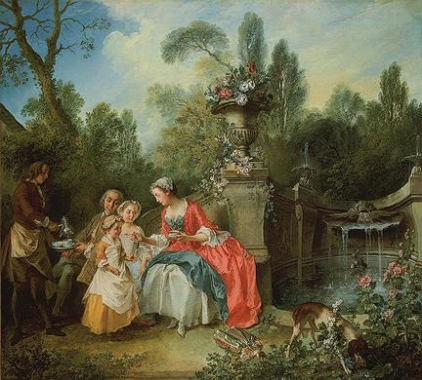Opera in four acts by Puccini (libretto by Giuseppe Giacosa and Luigi Illica, after Henri Murger’s novel Scènes de la vie de Bohème), produced in Turin in 1896. Setting: the Latin Quarter in Paris, 1830.
galop [Fr.]
A fast dance in 2/4 that was extremely popular in the middle of the 19th century, when it was often used as the concluding number of a ball. It was sometimes made the finale of a *quadrille. In the dance, embracing couples form a line and move rapidly with a galloping motion. In addition to numerous examples by composers of dance music such as the Johann Strausses, there are examples by Schubert, Liszt, Auber, Bizet, Prokofiev, Khachaturian, Kabalevsky, and Shostakovich. It is parodied in Offenbach’s Orphée aux enfers.
scherzando [It.]
hurdy-gurdy
(Fr. vielle à roue, chifonie; Ger. Drehleier, Leier, Radleier; It. ghironda; Lat. symphonia; Sp. zanfonia) A bowed stringed instrument, most often shaped like a viol, with a crank at the end opposite the pegbox. When the crank is turned, a rosined wooden wheel adjacent to the bridge and touching the strings rotates, causing the strings to sound.
The instrument was introduced into Latin Europe from the East and from Spain in the Middle Ages. By the 17th century, it was regarded as an instrument of the lower classes, including beggars and itinerant musicians. In the 18th century, however, it was taken up along with the *musette by the French aristocracy. Haydn composed five concertos (Hob. VIIh: 1-5) and eight *notturni (Hob. II: 25-32) for two instruments of this type with strings and winds. Mozart included the hurdy-gurdy in mixed ensembles for the four Minuets K. 601 and four German Dances K. 602.
BEOWULF: Hurdy-Gurdy & Theremin:
sinfonia [It.]
(pl. sinfonie) (1) Symphony. (2) In the Baroque period, an alternate designation for *sonata or *canzona, especially a trio or other ensemble sonata. This meaning reflects the derivation of sinfonia from the Greek word for “sounding together” and probably explains Bach’s use of the term for his three-part inventions. Sinfonias for keyboard or instrumental ensemble also served during this period as preludes to Mass and motet sections and to sets of dances. (3) In operas and other extended vocal works of the 17th and 18th centuries, an instrumental piece serving as a prelude or *overture, interlude, or postlude. As interludes, sinfonias were usually in one section of movement and often recurred several times, as in act 3 of Monteverdi’s Orfeo.
parlando [It., speaking]
cantino [It.]
aubade [French]
legg(i)ero [Italian]
Light, nimble, quick; sometimes non-legato.





